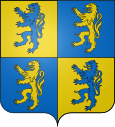Lescure-d'Albigeois
|
Lescure-d'Albigeois L'Escura d'Albigés |
||
|---|---|---|

|
|
|
| region | Occitania | |
| Department | Camouflage | |
| Arrondissement | Albi | |
| Canton | Albi-4 | |
| Community association | Albigeois | |
| Coordinates | 43 ° 57 ' N , 2 ° 10' E | |
| height | 154-302 m | |
| surface | 14.18 km 2 | |
| Residents | 4,577 (January 1, 2017) | |
| Population density | 323 inhabitants / km 2 | |
| Post Code | 81380 | |
| INSEE code | 81144 | |
| Website | Lescure-d'Albigeois | |
 Lescure d'Albigeois - Église Saint-Michel |
||
Lescure-d'Albigeois (Occitan: L'Escura d'Albigés ) is a French commune with 4,577 inhabitants (as of January 1, 2017) in the Tarn department in the Occitanie region .
location
Lescure-d'Albigeois lies at an altitude of approx. 160 m above sea level. d. M. and is only about six kilometers (driving distance) in a north-easterly direction from the center of Albi . The Tarn River forms the southern boundary of the municipality.
Population development
| year | 1800 | 1851 | 1901 | 1954 | 1975 | 1999 | 2012 |
| Residents | 1,400 | 2,182 | 1,411 | 1,794 | 2,810 | 3,660 | 4,424 |
In the 19th century, the population increased from 1,400 to over 2,000 at times. The re-establishment of the neighboring municipality of Le Garric , the phylloxera crisis in viticulture and the increasing mechanization of agriculture then led to a significant decline in the population. It only rose again in the 20th century because of its proximity to Albi.
economy
For centuries, the residents of the village lived on agriculture (grain, wine, vegetables) and livestock (milk, cheese, meat) as a self-sufficient living ; in the nearby town of Albi, they were able to sell excess produce in the market. Nowadays only a small amount of wine is grown; the majority of the residents find work in Albi.
history
A castle belonging to the French King Robert II is mentioned for the first time in a document from 1012 as Castrum scuriae ; However, the king gave it to his tutor Gerbert von Aurillac , who was Pope from 999 to 1003 . In the 11th century, a priory of the Benedictine Abbey of St.-Michel de Gaillac was established . In the early 13th century the castle was probably involved in the Albigensian Wars, as it was restored in 1229. In the course of the Hundred Years War (1337-1453) and in the time of the Huguenot Wars (1562-1598) it was again affected; the landlords ( seigneurs ) were Catholics. The Benedictine priory was dissolved a century before the French Revolution . In 1870, the municipality was significantly reduced as a result of the establishment of the municipality of Le Garric.
Attractions
- The former priory church of Saint-Michel-de-Lescure has served as a parish church since the 17th century and is surrounded by a cemetery ; It is a single nave and only one apsidial building - albeit with a transept - from the 12th century, the old crossing tower of which collapsed sometime in the 16th or 17th century and destroyed the barrel vault of the church, which was then replaced by an open roof structure ; The crossing tower was also renewed - partly with bricks . The apse and nave walls are stabilized and articulated with buttresses ; the apse has a figuratively designed console frieze below the eaves , which is missing in the nave. The most important ornament of the church is its portal, the capitals (one shows the sacrifice of Isaac ) and archivolts arches are richly decorated with figures and ornaments - a narrow frieze with predatory animals, whose bodies are grouped in pairs and whose heads point outwards, is particularly noteworthy. There is another console frieze above the portal. The church building was already included in the list of Monuments historiques in 1883 .
- The Notre-Dame-de-la-Drèche church is also located in the urban area of Albi and the municipal area of Cagnac-les-Mines . The late Gothic church, which was completely redesigned in the second half of the 19th century, based on the model of Albi Cathedral, served as a pilgrimage church for centuries and has been recognized as a monument historique since 1995 .
- The Église Saint-Pierre is an inconspicuous brick building from the 14th century.
- The Tour de l'Horloge city gate is the last remnant of the city fortifications ( remparts ) built or renovated in the 14th and 15th centuries . The brick building was recognized as a monument historique as early as 1911 .
Personalities
- Thierry Carcenac (* 1950), politician
Web links
- Lescure d'Albigeois, Viticulture - Info (French)
- Lescure d'Albigeois, history - information (French)
- Lescure d'Albigeois, sights - photos + information (French)
Individual evidence
- ↑ Église Saint-Michel, Lescure-d'Albigeois in the Base Mérimée of the French Ministry of Culture (French)
- ↑ Église Notre-Dame-de-la-Drèche, Albi etc. in the Base Mérimée of the French Ministry of Culture (French)
- ↑ Porte de ville dite Tour de l'Horloge, Lescure-d'Albigeois in the Base Mérimée of the French Ministry of Culture (French)

